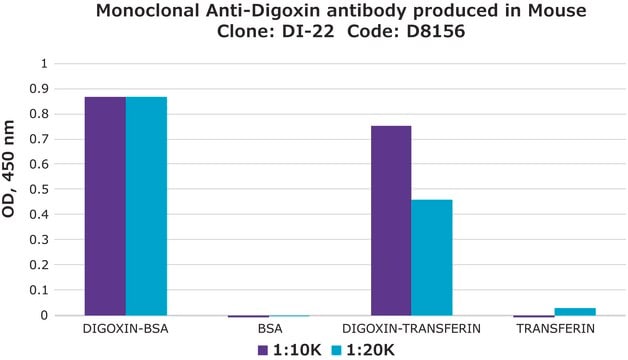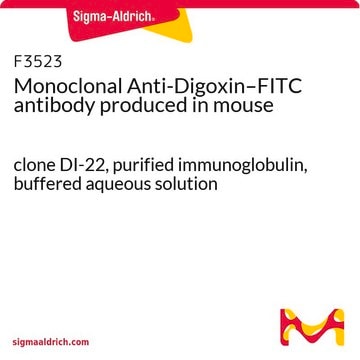11207733910
Roche
Anti-Digoxigenin-POD, Fab fragments
from sheep
Synonym(s):
anti-digoxigenin, digoxigenin
Sign Into View Organizational & Contract Pricing
All Photos(1)
About This Item
UNSPSC Code:
12352203
Recommended Products
biological source
sheep
Quality Level
conjugate
peroxidase conjugate
antibody form
F(ab′)2 fragment of affinity isolated antibody
antibody product type
primary antibodies
clone
polyclonal
form
lyophilized (clear, brown solution after reconstitution)
packaging
pkg of 150 U
manufacturer/tradename
Roche
storage temp.
2-8°C
General description
Digoxigenin is a hapten, useful in labeling nucleic acids and in detection systems. This product contains Fab fragments from an anti-digoxigenin antibody, conjugated with horse-radish peroxidase (POD). Anti-Digoxigenin-POD, Fab fragments is useful for the detection of digoxigenin-labeled compounds.
Specificity
The polyclonal antibody from sheep is specific to digoxigenin and digoxin and shows no cross-reactivity with other steroids, such as human estrogens and androgens.
Application
Use Anti-Digoxigenin-POD, Fab fragments for the detection of digoxigenin-labeled compounds using:
- Dot blot
- ELISA
- Immunohistocytochemistry
- In situ hybridization
- Western blot
Preparation Note
After immunization with digoxigenin, sheep IgG was purified by ion-exchange chromatography, and the specific IgG was isolated by immunosorption. The Fab fragments obtained by papain digestion were purified by gel filtration, conjugated to the specific label, and stabilized in buffer.
Working concentration: Working concentration of conjugate will depend on the application and substrate. The following concentrations should be taken as a guideline: Dot blot: 150 mU/ml
Working solution: 100 mM Tris-HCl, 150 mM NaCl, pH 7.5.
1% Blocking reagent (w/v), 1 to 5% heat inactivated fetal calf serum (v/v) or sheep normal serum can be used for reduction of unspecific binding.
Working concentration: Working concentration of conjugate will depend on the application and substrate. The following concentrations should be taken as a guideline: Dot blot: 150 mU/ml
- ELISA: 50 to 150 mU/ml
- Immunohistocytochemistry: 250 to 500 mU/ml
- In situ hybridization: 1.5 to 7.5 U/ml
- Southern blot: 150 mU/ml
- Western blot: 250 to 500 mU/ml
Working solution: 100 mM Tris-HCl, 150 mM NaCl, pH 7.5.
1% Blocking reagent (w/v), 1 to 5% heat inactivated fetal calf serum (v/v) or sheep normal serum can be used for reduction of unspecific binding.
Reconstitution
Add 1 ml double-distilled water to a final concentration of 150 U/ml.
Other Notes
For life science research only. Not for use in diagnostic procedures.
Not finding the right product?
Try our Product Selector Tool.
Signal Word
Warning
Hazard Statements
Precautionary Statements
Hazard Classifications
Skin Sens. 1
Storage Class Code
11 - Combustible Solids
WGK
WGK 1
Flash Point(F)
does not flash
Flash Point(C)
does not flash
Choose from one of the most recent versions:
Already Own This Product?
Find documentation for the products that you have recently purchased in the Document Library.
Customers Also Viewed
Yutaka Daido et al.
Developmental biology, 392(1), 117-129 (2014-05-07)
The vertebrate retina contains two types of photoreceptor cells, rods and cones, which use distinct types of opsins and phototransduction proteins. Cones can be further divided into several subtypes with differing wavelength sensitivity and morphology. Although photoreceptor development has been
Sarah E Mercer et al.
PloS one, 7(12), e52375-e52375 (2013-01-10)
The inability to functionally repair tissues that are lost as a consequence of disease or injury remains a significant challenge for regenerative medicine. The molecular and cellular processes involved in complete restoration of tissue architecture and function are expected to
Hande Tunbak et al.
eLife, 9 (2020-05-06)
The zebrafish was used to assess the impact of social isolation on behaviour and brain function. As in humans and other social species, early social deprivation reduced social preference in juvenile zebrafish. Whole-brain functional maps of anti-social isolated (lonely) fish
X Peng et al.
Leukemia, 29(12), 2355-2365 (2015-06-25)
Controlled self-renewal and differentiation of hematopoietic stem/progenitor cells (HSPCs) are critical for vertebrate development and survival. These processes are tightly regulated by the transcription factors, signaling molecules and epigenetic factors. Impaired regulations of their function could result in hematological malignancies.
Allison J Bardin et al.
Development (Cambridge, England), 137(5), 705-714 (2010-02-12)
Adult stem cells maintain tissue homeostasis by controlling the proper balance of stem cell self-renewal and differentiation. The adult midgut of Drosophila contains multipotent intestinal stem cells (ISCs) that self-renew and produce differentiated progeny. Control of ISC identity and maintenance
Our team of scientists has experience in all areas of research including Life Science, Material Science, Chemical Synthesis, Chromatography, Analytical and many others.
Contact Technical Service








